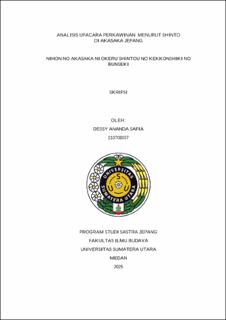| dc.description.abstract | This study analyzes Shinto wedding ceremonies in Akasaka, Japan, which aims to describe the stages of the Shinto wedding procession in Akasaka and analyze the meaning of the colors and symbols used in each stage. The method used is descriptive qualitative with data collection techniques through literature studies, visual documentation observations, and semiotic analysis. The theories employed in this research are performance theory and semiotic theory. The results of the study show that the Shinto wedding ceremony in Akasaka consists of a series of sacred processions such as Sanshin (escort to the Jinja altar), Shubatsu (self-purification), Norito Soujou (prayer reading), San-san-kudo (sake drinking), Mikushi Azuke no Gi (handing over combs), Tamagushi Hoten (offerings to the gods), Seishihoudoku (reading of wedding vows), Yubi wa no Koukan (ring exchange), Ryouke Daihyou Tamagushihoden (offerings to the gods by family representatives), to Shinzoku Katame no Sakazuki (sharing sake between the two families). Color analysis reveals philosophical meanings, such as white symbolizing purity and new beginnings, black symbolizing honor and formality, red symbolizing protection and good fortune, gold symbolizing glory and blessings, and green symbolizing fertility and harmony. Ritual symbols such as sake, tamagushi, red umbrellas, and combs have spiritual, social, and aesthetic value that reinforce the meaning of marriage. This research confirms that Shinto weddings in Akasaka reflect a balance between preserving tradition and adapting to modern life. | en_US |


